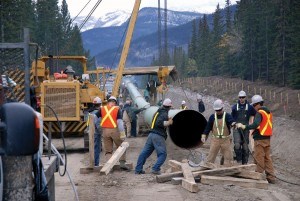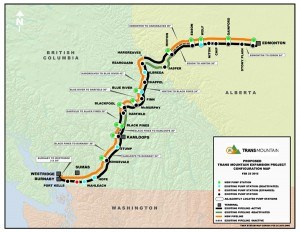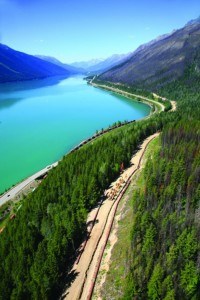
Since the federal government approved Kinder Morgan’s Trans Mountain pipeline expansion, Nov. 29, people have been left with many questions.
The Fitzhugh has a compiled a timeline, highlighting the past, present and future of the Trans Mountain pipeline expansion project within Jasper National Park (JNP).
1953: Trans Mountain comes to JNP
The Trans Mountain pipeline system began transporting crude oil from northern Alberta—through Jasper National Park—to Burnaby, BC in 1953.
2004: Anchor Loop project proposal
Hoping to expand the existing pipeline, Trans Mountain consulted with local stakeholders, environmental groups, Aboriginal Peoples and other interested parties.
According to a 1951 Canadian government charter granted to the Trans Mountain project, it gave Kinder Morgan the authority to proceed through JNP with its Anchor Loop Project.
2008: Anchor Loop project complete
In 2008, Kinder Morgan completed the Anchor Loop project, which involved installing a second pipeline adjacent to the existing Trans Mountain pipeline—a 158-kilometre section between Hinton, Alta., and Hargreaves, B.C., just west of Mount Robson Provincial Park.
This project included twinning the pipeline across Jasper National Park and Mount Robson Provincial Park and is intended to be reactivated once the rest of the pipeline is built.
2013: Trans Mountain submits expansion proposal

After more than a year of planning and public consultations, Trans Mountain submitted its proposal to the National Energy Board (NEB) for an expansion of its existing 1,150-km oil pipeline between Strathcona County, Alta., and Burnaby, B.C.
The proposed expansion would include building approximately 987 km of new pipeline and reactivating 193 kms of existing pipeline–the majority of which already runs through Jasper National Park.
May 2016: NEB conditionally approves expansion
Kinder Morgan’s Trans Mountain pipeline moved one step closer to getting Alberta’s landlocked oil to tidewater after the National Energy Board (NEB) conditionally approved the proposed project with 157 conditions, May 19.
The federal government was then given seven months to make a decision on the proposed project. Without federal approval the project would not be able to move ahead.
If given the green light, the company would still be required to meet all of the NEB’s conditions, including 49 environmental requirements, before it could twin the 1,150 km long pipeline.
November 2016: Expansion gets federal approval
The federal government approved Kinder Morgan’s Trans Mountain pipeline expansion, Nov. 29.
The $6.8-billion project envisions tripling the amount of oil transported by pipeline running directly through JNP. The expansion would reactivate 193 kms of existing pipeline. Once completed, the twinning will allow 890,000 barrels of oil to pass through the park a day, nearly three times the amount that travels through it today.
Trans Mountain must still meet NEB’s 157 conditions.
September 2017: Construction could begin
Construction and reactivation of the Trans Mountain pipeline could begin in September 2017. Kinder Morgan hopes to have the new line up and running by December 2019.

What does reactivation mean and what does it look like?
Trans Mountain has completed a number of expansion projects since the original line became operational in 1953. As a result, about 28 per cent of the 1,150-km pipeline system between Strathcona County, Alta., and Burnaby, B.C. is already twinned.
The 28 per cent of the system that currently has two pipelines has an active and a deactivated segment of pipeline. The deactivated segments are monitored and maintained similarly to the active pipeline, in anticipation of future use.
The proposed Trans Mountain Expansion project requires reactivation of two pipeline segments that have been maintained in a deactivated state. Returning these segments back into service is needed to complete the twinning of the pipeline system.
Inactive pipeline segments that are proposed to be brought back into service include:
- Hinton to Hargreaves, B.C. – approximately 150 km
- Darfield to Black Pines, B.C. – approximately 43 km
The inactive sections of the Trans Mountain pipeline and any other pipe segments that are not currently in use are included as part of Trans Mountain’s ongoing integrity management program.
This means the inactive segments are continuously protected against external corrosion with the same level of protection as the active pipeline. These segments are also charged with nitrogen internally which maintains an inert environment and protects against internal corrosion.
Emergency management plan:
According to Kinder Morgan, practices that focus on preventing pipeline failures and minimizing their impact are also a part of the integrity management program. This program identifies all of the hazards that have the potential to affect the safety of the pipeline system and ensures that control measures are implemented to prevent or mitigate the occurrence and potential impact of each hazard.
Additionally, NEB is responsible for regulating the ongoing operations of pipelines in Canada. As a federally regulated company Kinder Morgan is regularly audited by the NEB.
However, in the case of a spill, Kinder Morgan said it is prepared to respond quickly with detailed emergency procedures and trained professionals.
The goals and objectives of the company are to:
- Build and enhance relationships with external organizations that may be called upon to respond to an emergency;
- Employ an integrated all-hazards risk based approach for mitigation, response and recovery during an emergency;
- Enhance preparedness capabilities through training and exercises;
- Respond to emergency condition reports in a timely manner.
